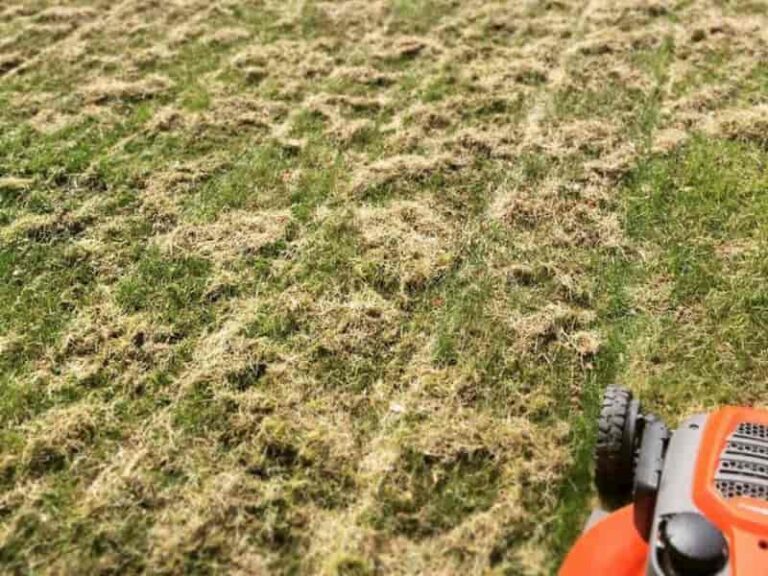How to Make Centipede Grass Thicker and Fuller
A centipede lawn has the lowest maintenance needs compared to other warm-season grasses. It is often called the lazy man’s lawn because it requires less fertilizer and infrequent mowing (low maintenance). However, the turf will easily grow thin with weeds and diseases taking over if you don’t give it proper care. So, how do you make centipede grass spread, thicker and fuller?
Apply 1-2 pounds of nitrogen fertilizer per 1000 sq. ft. of lawn during the active growing months to make centipede grass grow thicker and fuller. Also, provide 1 inch of water weekly and mow the lawn at 1-1.5 inches high to maintain its vigor. Overseed the lawn if there are any thin areas.
Table of Contents
Why is my centipede lawn thin?
Your centipede lawn is thin due to compacted soils and thatch build-up. When the soil particles are too close, oxygen cannot penetrate to reach the root hairs. Oxygen is essential to keep the root hairs active to transport water and mineral salts to keep the grass thicker.
Thatch blocks water from penetrating to reach the root hairs; hence, the grass gets insufficient water for use. Inadequate water causes the blades to remain thinner than before leading to centipede grass decline and other problems.
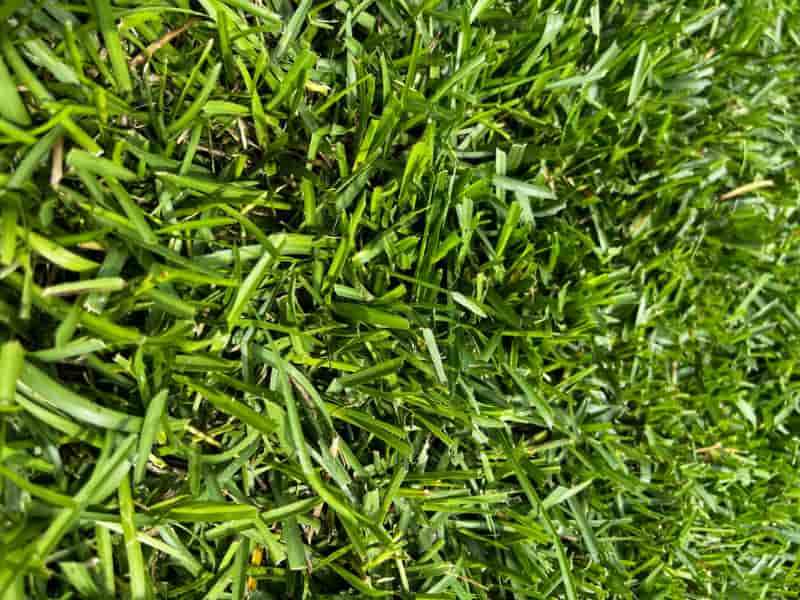
How to make centipede grass thicker
Maintaining a thick and full centipede lawn is a great way to prevent invasive weeds from taking over your lawn. The turf will also appear a lot more beautiful than when it’s thin and barely green. To achieve a great-looking centipede lawn, you want to make sure you stick to a proper centipede grass care routine and schedule.
Here’s how to make centipede grass spread, thicker and fuller:
1. Water the grass deeply but infrequently
Water centipede grass to 1 inch of water in the dry months of winter to prevent winter desiccation and thinning. In the hot months of summer, water the lawn to protect the grass from drought stress. Apply less than 1 inch of water once per week in summer and reapply if centipede grass blades begin to dry and appear bluish.
Even when the grass is dormant, continue irrigating to prevent dehydration. Be sure to water deeply but infrequently to grow thicker centipede grass. However, don’t overwater the lawn as it can lead to weak roots, which are more susceptible to diseases and encourage weeds to grow.
Watering centipede grass will ensure it gets the correct amount of water at the time of need and will grow healthier and thicker.
2. Mow infrequently at 1 to 1.5 inches high
Mowing encourages grass to grow healthier and thicker. However, centipede grass shouldn’t grow taller than 2 inches. Set the mower to 1.0 or 1.5 inches when mowing. Don’t cut the grass lower than 1.0 inches because it can cause scalp injury, thus making the grass more susceptible to diseases and encouraging shallow roots. Meanwhile, cutting the grass higher than 1.5 inches deteriorates it.
Mow centipede grass about 1.5 inches during summer and gradually decreases height as the season progresses. Set the mower higher when the grass undergoes environmental stress, such as high temperatures and less water supply.
Be sure to use a sharp blade when mowing because blunt edges tear up the grass. Also, torn turf is more vulnerable to diseases and pests. Finally, remember to cut less than 1/3 of the total height of grass and leave the clippings on the lawn to decay and add more nutrients to the soil.
3. Overseed the lawn to fill bare spots
Add new centipede grass seeds to the existing turf to grow denser and thicker grass blades. I’d also advise that you overseed when bare spots on the lawn make the turf appear thinner.
Other grass varieties can be added to improve the centipede lawn; Bermuda grass is a great choice to mix with centipedegrass to improve its hardiness to diseases.
A great time to overseed your lawn is a few weeks after the last frost or at the beginning of the growing season in spring. You can maintain a thicker and denser turf simply by killing weeds and overseeding routinely.
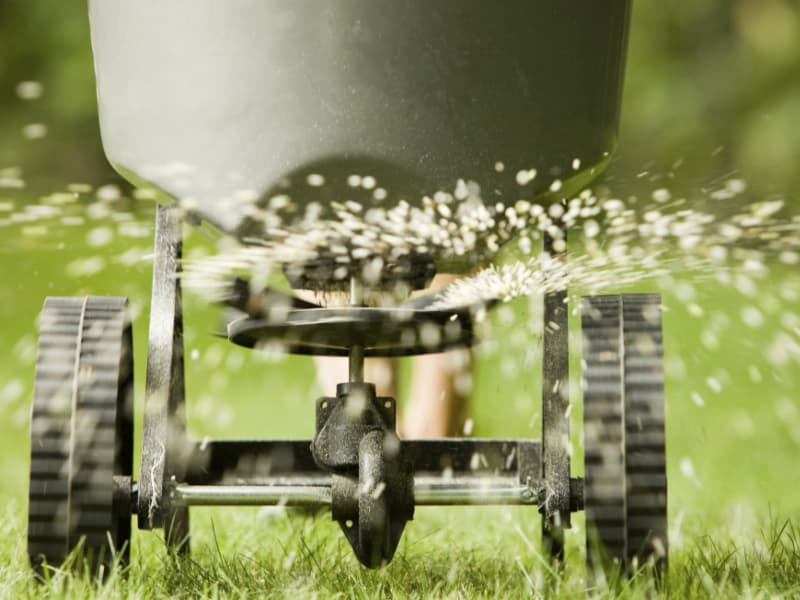
Here’s how to overseed centipede lawn to grow thicker, fuller lawn:
- Remove all debris like dropped leaves, dead stems, roots, and other specks of dirt that might be lying on the lawn area to spread the seeds quickly.
- Mow the grass to one inch tall to expose the soil so the seeds can contact the ground when applied. Bag the grass clippings while mowing.
- Aerate the lawn using a core aerator to loosen the compact soils to create more spaces for air penetration. You can also use a rake to scratch the ground when breaking complex soil clusters profoundly.
- Add centipede grass seeds to the aerated lawn; for a small area, use a hand spreader but a broadcast spreader for larger sizes. It’s vital to set the spreader to the correct setting to distribute the seeds evenly to all parts of the lawn. After adding seeds to the area, cover them with 1/8 inch of soil or the grass clippings you bagged when mowing. Soil and clippings will help retain the grass seeds’ moisture to germinate.
- Add a starter fertilizer like Scotts Turf Builder Starter Food for New Grass to produce greener, denser, thicker turf and establish strong fibrous roots for the germinating grass. The seeds will grow up to 35% faster if you add the lawn food. Apply the fertilizer at a rate of 1 pound per 1000 square feet. Don’t add any herbicides or pesticides at this point.
- Water the grass to activate the starter fertilizer and grow the grass seeds. Water twice daily to 1 and 2 inches deep into the soil. As the seeds grow, water the seedlings once per day. After 6-8 weeks of germination, start other maintenance practices like mowing the lawn to 1.5 inches, adding more lawn food, and applying pesticides and herbicides to cure diseases and kill weeds.
4. Aerate compacted soils
Aerating solid soils create air spaces that allow oxygen penetration to facilitate other processes, such as transporting essential nutrients to where they are needed to grow thicker grass blades.
Aerate the lawn once per year at the beginning of summer. You can use a core aerator to loosen the soil or rake them using a hand rake.
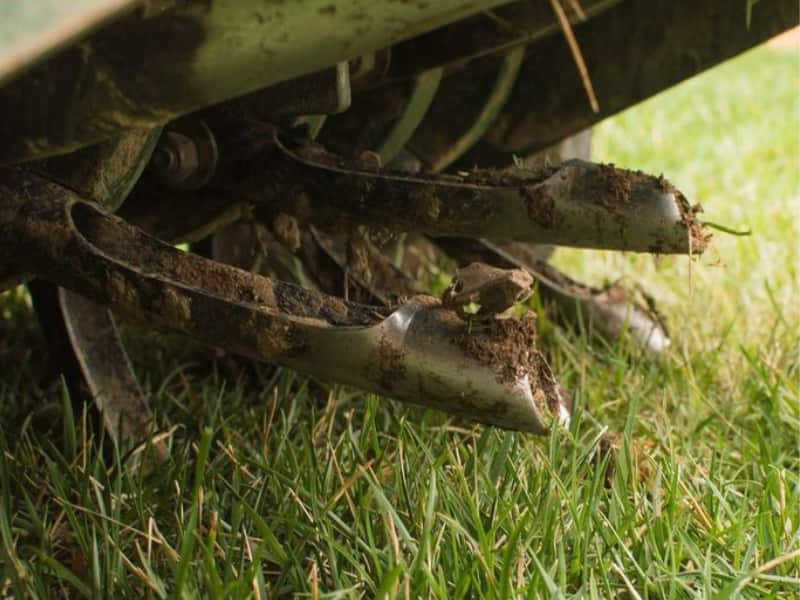
5. Dethatch the lawn
Thatch build-up on the lawn prevents water penetration to the turf roots. In addition, the remains of dead stolons and leaves form a breeding ground for insects causing fungal infections. Thatch thicker than ½ inch also leads to shallow roots.
Dethatch the lawn to remove the remains that prevent water from penetrating deep into the root zone. The turf will grow deep roots if it receives enough water and becomes thicker. Use a rake to break and remove the remains to create a conducive environment for turf to survive. Regular thatch removal will help keep them thinner than ½ an inch.
6. Apply fertilizers
Though centipede grass doesn’t require frequent fertilization to grow thicker and healthier, minimal amounts of less than 2 pounds of actual nitrogen per 1000 square feet per year can be applied to boost its health. 2 pounds is more appropriate if your soil is sandy, but if it’s clay, add lower amounts.
Be careful not to add more than 2 lbs of fertilizer because it will cause brown patches of burnt grass on your lawn, thatch build-up, and make centipede grass more vulnerable to disease. High phosphorus levels also reduce iron available in the soil, causing yellowing grass blades.
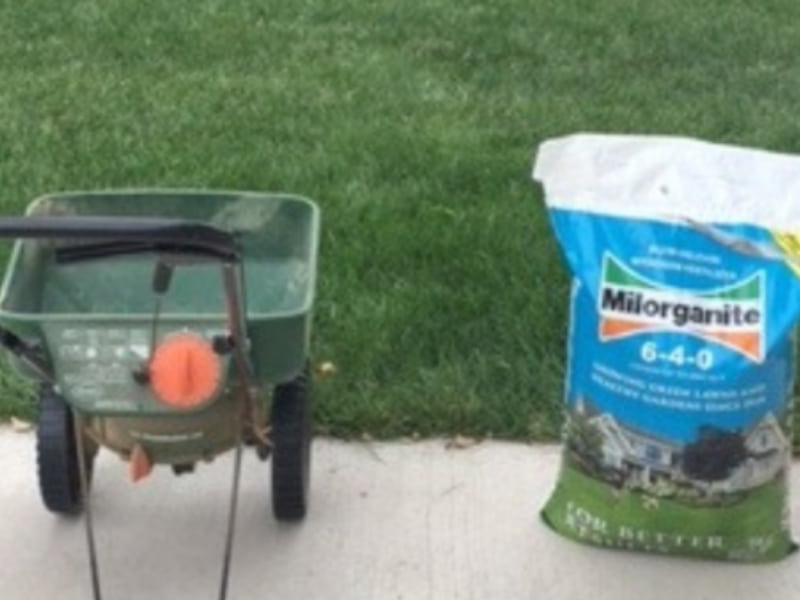
Always do a comprehensive soil analysis to determine the pH and nutrients lacking before adding any fertilizer to the lawn. Fertilizers with NPK ratios of 18-0-18, 15-0-15, and 16-4-8 are the most appropriate for use on centipede grass lawns with inadequate phosphorus. The Anderson PGF Complete Fertilizer is a good lawn food with an NPK ratio of 16-4-8.
Don’t add any nitrogen fertilizer in March through May, but add iron fertilizer if the turf appears yellow. Iron sulfate and iron chelates are examples of iron-rich fertilizers to add to centipedegrass lawns with iron deficiency.
Three weeks after the grass greens up in June, apply 0.5 pound of nitrogen fertilizer per 1000 square feet.
As the growing season continues, add another 0.25 to 0.75 pounds of actual nitrogen slow-release fertilizer per 1000 square feet of centipede lawn between June and July. I recommend using Milorganite Lawn Fertilizer as it is organic and releases nitrogen slowly. If the soil test detected lower than 5.0 pH level, add lime to the soil.
However, if the pH is higher than 6.0, add sulfur to lower it, and temperatures must be below 75oF during application. Phosphorus fertilizer should not be applied during the growing season unless a soil test detects its deficiency in the soil.
As the growing season ends, add the last 0.5 pounds of nitrogen fertilizer per 1000 square feet before mid-August. You can add Potassium fertilizer to prepare centipede grass as it enters the dormancy period.
Don’t add any nitrogen fertilizer in September and November because the grass is dormant. However, apply 1 pound of potassium per 1000 square feet before the first expected frost to improve the turf’s hardiness to cold and diseases.
An excellent fertilizer to use here could be 1.6 pounds of muriate of potash per 1000 square feet. Two pounds of sulfate of potash per 1000 square feet is another alternative to use if the soil test indicated a higher than 6.0 soil pH level. Lime can also be added to raise pH lower than 5.0.
Fertilizing centipede grass timely with the appropriate lawn food will produce a greener, denser, and thicker centipedegrass lawn.
7. Kill weeds
Weeds such as crabgrass, goosegrass, and sandburs compete with centipedegrass for nutrients, water, and sunlight to grow. Lack of sufficient nutrients and water makes centipede grass unhealthy and thin.
Kill and remove weeds from the lawn so that the centipede can get all the nutrients it requires to grow healthy and thicker.
Apply pre-emergent herbicides in mid-February or mid-March to kill any weed seeds in the lawn before they grow and add a second treatment after eight weeks. Finally, apply post-emergent selective herbicides to kill any grassy weeds and broadleaf winter weeds.
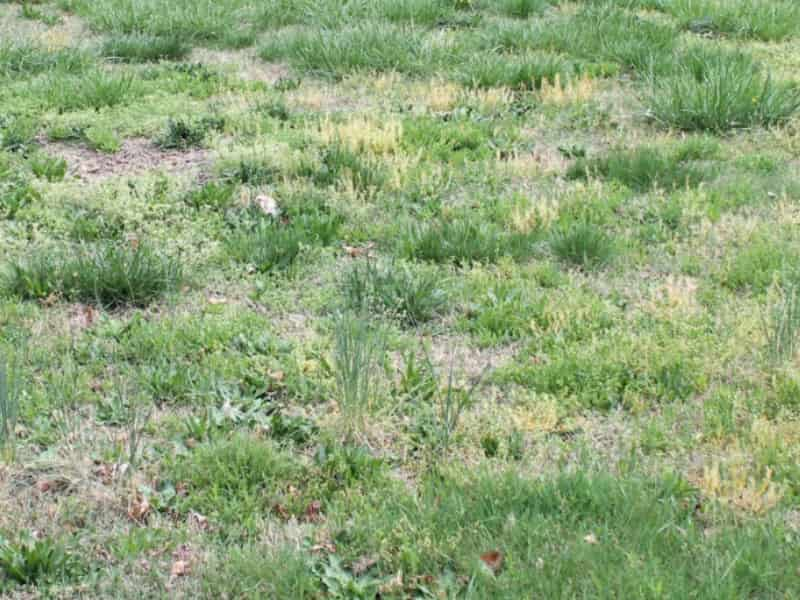
Post-emergent herbicide should be applied when the grass and weeds are actively growing, and the turf should be stress-free from drought, cold, or diseases. In addition, the soil temperature during application should be below 90oF. Don’t remove any weed that emerges from the lawn when the grass has begun greening up. Instead, wait for the turf to fully green before killing the weeds with a post-emergent herbicide.
- Tenacity turf herbicide is a perfect selective post-emergent herbicide you can use to kill any crabgrass from a centipedegrass lawn.
- DSMA and Roundup Power Max are other effective post-emergent herbicides though they are non-selective. Use them as a spot treatment to avoid killing nearby turf.
8. Control insects and diseases
Insects such as mole crickets suck nutrients from centipedegrass, thus reducing the quantity of available nutrients. Insects are usually away from a centipede lawn during winter because of the cold soil.
As the temperature warms up in summer, insects such as grubs and nematodes attack centipede grass causing severe damage. Apply insecticides in mid-July to kill the tiny eggs of mole crickets and grubs. Consult your local agricultural experts to advise on the most appropriate insecticides to use.
The large patch is the most common disease that attacks centipedegrass in the growing season. Circular yellow or brown patches appear and grow larger on the lawn. Apply a fungicide to control them. Keep the grass dry and thatch to less than ½ an inch to prevent large patch disease.
How do you fix thinning centipede grass?
Lack of nutrients, compacted soils, improper mowing, pests, diseases, shade are the main cause centipede grass thinning. To fix thinning you need to identify the cause and address it Grass thinning can be fixed mainly through applying fertilizer, aerating lawn, dethatching, watering, proper mowing, correcting soil pH, and filling in bare spots with plugs or sprig and sods.
How do you revive dead centipede grass?
Centipede decline can be due to lack of water, inadequate nutrients disease and pests. Lawn care practices (watering, pest and disease control, correct mowing, aeration and fertilization) will encourage your centipede to recover from decline or die-off. Make sure you correctly identify and address the underlying cause as well.
What is the best watering schedule for centipede grass?
Proper watering is key to keeping centipede grass healthy during the growing season. Centipede grass requires 1-1.5 inches of water per week in growing season either from rainfall or irrigation. Adjust watering schedule based on weather, season, and signs of stress in your lawn. Centipede grass has shallow roots water infrequently but deeply once or twice a week early in the morning, before 10am for best results.
References
- Richard L. Duble, Turfgrass Specialist Texas Cooperative Extension: Centipedegrass.
- Grady Miller, Professor & Extension Specialist, Crop & Soil Sciences NC State University: Centipedegrass Lawn Maintenance Calendar
- Kent Shannon, University of Missouri: Lawn Fertilizer Calculator

